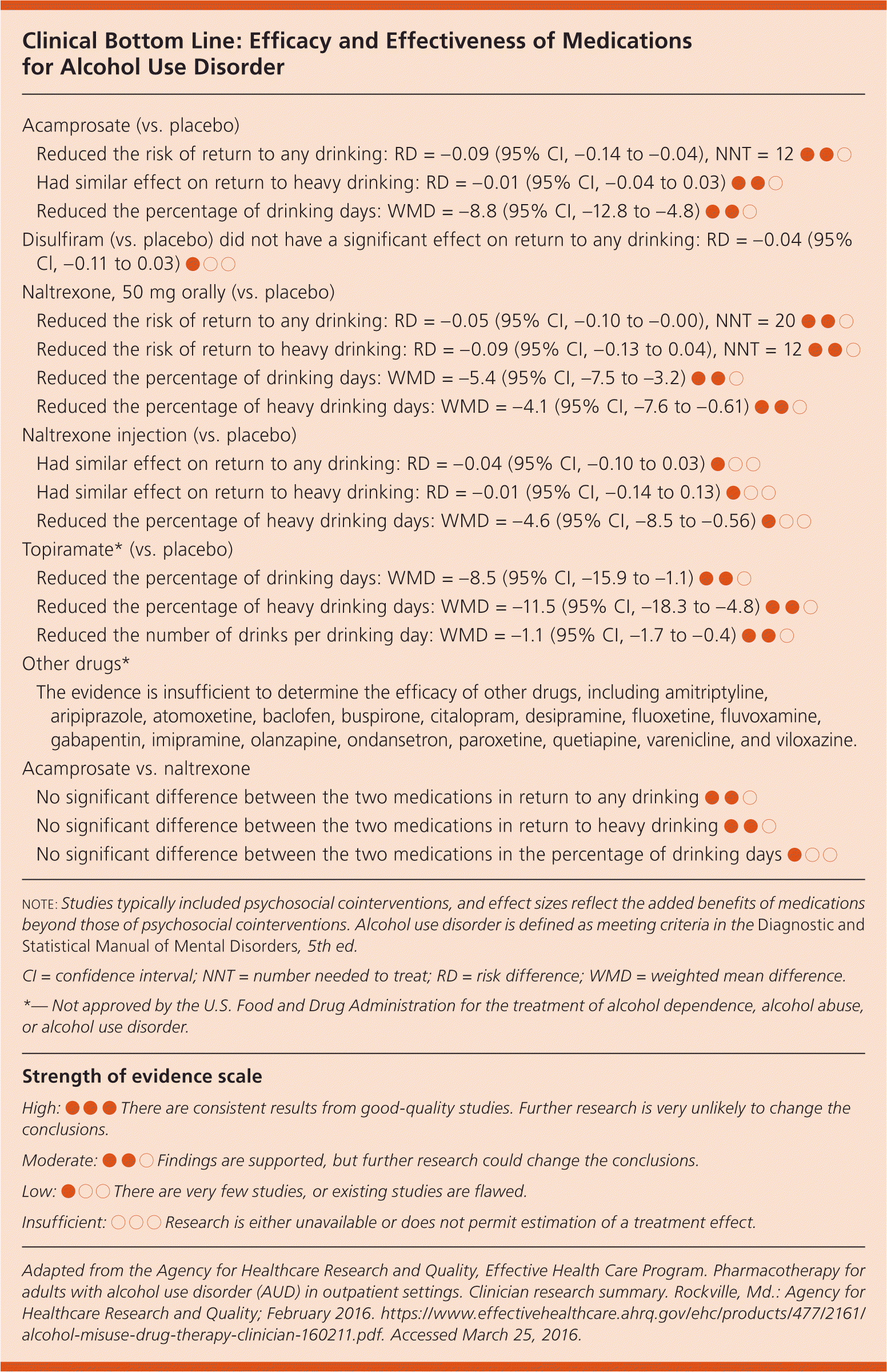
Am Fam Physician. 2016;94(2):155-157
Author disclosure: No relevant financial affiliations.
Key Clinical Issue
What are the potential benefits and adverse effects of medications used to treat alcohol use disorder (AUD) in adult outpatients?
Evidence-Based Answer
The oral medications acamprosate, naltrexone, and disulfiram, and the long-acting injectable formulation of naltrexone have been approved by the U.S. Food and Drug Administration for AUD. Acamprosate and oral naltrexone improve alcohol consumption outcomes for patients with AUD. (Strength of recommendation [SOR]: C, based on disease-oriented evidence.) However, studies directly comparing these medications have not consistently established the superiority of one medication over another.
Evidence related to injectable naltrexone is currently limited. Evidence from well-controlled trials of disulfiram suggests that treatment with disulfiram does not result in an overall reduction in alcohol consumption. (SOR: C, based on disease-oriented evidence.) Evidence is insufficient to permit conclusions about the effect of acamprosate or naltrexone on health outcomes (e.g., mortality, quality of life, function, accidents).
Practice Pointers
Primary care physicians commonly encounter adults with AUD. In 2013, the prevalence of AUD among adults in the United States was 7%,1 and alcohol misuse is the third leading cause of preventable death in the United States, after tobacco use and obesity.2 The U.S. Preventive Services Task Force recommends that physicians routinely screen adults for alcohol misuse and provide brief behavioral counseling interventions to reduce alcohol misuse.3 Alcohol use was previously subcategorized as harmful use, alcohol abuse, and alcohol dependence; however, the Diagnostic and Statistical Manual of Mental Disorders, 5th ed., outlines criteria for a single diagnosis of AUD that is measured from mild to severe depending on symptoms.4
Of the medications approved by the U.S. Food and Drug Administration for AUD, there is moderate evidence that acamprosate and oral naltrexone reduce alcohol consumption outcomes. A meta-analysis comparing acamprosate and oral naltrexone did not find a statistically significant difference between the two drugs with regard to return to any drinking5–8 or return to heavy drinking.5–7 Most studies included a psychosocial intervention in addition to the medication.

| Acamprosate (vs. placebo) | |
| Reduced the risk of return to any drinking: RD = −0.09 (95% CI, −0.14 to −0.04), NNT = 12 ● ● ○ | |
| Had similar effect on return to heavy drinking: RD = −0.01 (95% CI, −0.04 to 0.03) ● ● ○ | |
| Reduced the percentage of drinking days: WMD = −8.8 (95% CI, −12.8 to −4.8) ● ● ○ | |
| Disulfiram (vs. placebo) did not have a significant effect on return to any drinking: RD = −0.04 (95% Cl, −0.11 to 0.03) ● ○ ○ | |
| Naltrexone, 50 mg orally (vs. placebo) | |
| Reduced the risk of return to any drinking: RD = −0.05 (95% CI, −0.10 to −0.00), NNT = 20 ● ● ○ | |
| Reduced the risk of return to heavy drinking: RD = −0.09 (95% CI, −0.13 to 0.04), NNT = 12 ● ● ○ | |
| Reduced the percentage of drinking days: WMD = −5.4 (95% CI, −7.5 to −3.2) ● ● ○ | |
| Reduced the percentage of heavy drinking days: WMD = −4.1 (95% CI, −7.6 to −0.61) ● ● ○ | |
| Naltrexone injection (vs. placebo) | |
| Had similar effect on return to any drinking: RD = −0.04 (95% CI, −0.10 to 0.03) ● ○ ○ | |
| Had similar effect on return to heavy drinking: RD = −0.01 (95% CI, −0.14 to 0.13) ● ○ ○ | |
| Reduced the percentage of heavy drinking days: WMD = −4.6 (95% CI, −8.5 to −0.56) ● ○ ○ | |
| Topiramate* (vs. placebo) | |
| Reduced the percentage of drinking days: WMD = −8.5 (95% CI, −15.9 to −1.1) ● ● ○ | |
| Reduced the percentage of heavy drinking days: WMD = −11.5 (95% CI, −18.3 to −4.8) ● ● ○ | |
| Reduced the number of drinks per drinking day: WMD = −1.1 (95% CI, −1.7 to −0.4) ● ● ○ | |
| Other drugs* | |
| The evidence is insufficient to determine the efficacy of other drugs, including amitriptyline, aripiprazole, atomoxetine, baclofen, buspirone, citalopram, desipramine, fluoxetine, fluvoxamine, gabapentin, imipramine, olanzapine, ondansetron, paroxetine, quetiapine, varenicline, and viloxazine. | |
| Acamprosate vs. naltrexone | |
| No significant difference between the two medications in return to any drinking ● ● ○ | |
| No significant difference between the two medications in return to heavy drinking ● ● ○ | |
| No significant difference between the two medications in the percentage of drinking days● ○ ○ | |
Important factors to consider when deciding between acamprosate and oral naltrexone for AUD include dosing regimen, contraindications, and potential adverse effects. Acamprosate dosing is two 333-mg tablets three times per day, compared with 50 to 100 mg once per day for oral naltrexone. Because acamprosate is cleared through the kidneys, it is contraindicated in patients with renal failure, and dosing should be adjusted for patients with moderate renal impairment. Oral naltrexone is metabolized through the liver, and is therefore contraindicated in patients with liver failure and acute hepatitis; caution should be used in the presence of other liver diseases depending on potential risks and benefits. Additionally, naltrexone blocks opioid receptors, so it should not be used in patients who are using, or will need to use, opioids because it inhibits the effects and can precipitate withdrawal symptoms in dependent individuals. Results of a meta-analysis found that patients taking acamprosate were more likely to report anxiety, diarrhea, and vomiting compared with those taking placebo. Patients taking oral naltrexone had higher rates of dizziness, nausea, and vomiting compared with those taking placebo. A free guide for clinicians on medications for the treatment of AUD is available from the Substance Abuse and Mental Health Services Administration at http://store.samhsa.gov/shin/content//SMA15-4907/SMA15-4907.pdf.
editor's note: American Family Physician SOR ratings are different from the AHRQ Strength of Evidence (SOE) ratings.
